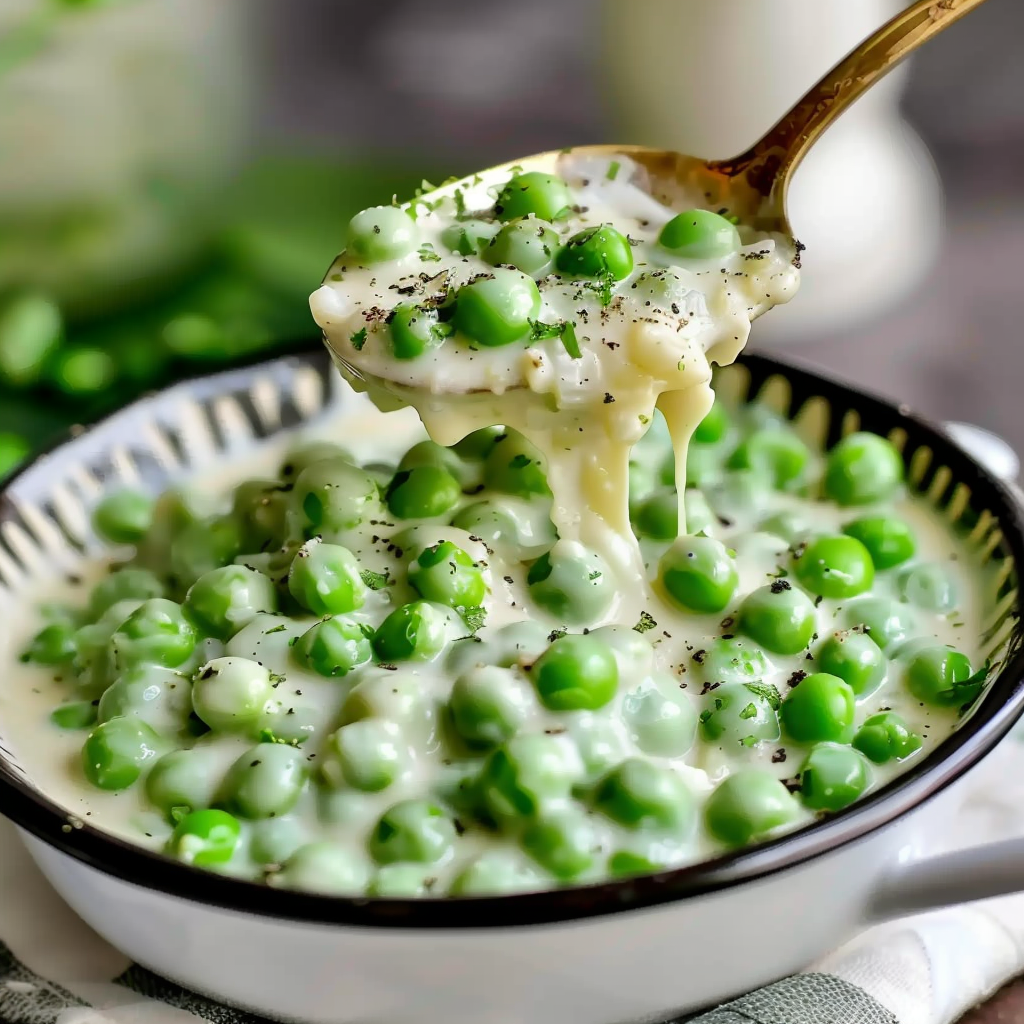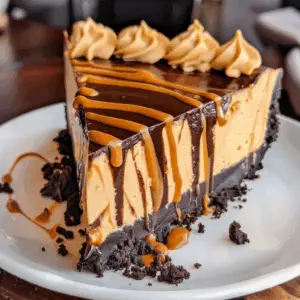1.The Allure of Creamed Peas
When it comes to timeless vegetable side dishes, creamed peas consistently earn a top spot. Their silky, rich texture and subtle sweetness make them an ideal pairing for nearly any main course—from roast chicken to grilled fish. Whether you’re preparing a festive holiday spread or a weeknight family dinner, creamed peas offer a balance of simplicity and comfort.
One reason this dish endures is its incredible adaptability. You can enjoy it as-is or modify it with ingredients like Parmesan, herbs, or crispy bacon to create exciting new flavors. Plus, it’s one of the few side dishes that require minimal prep time but deliver maximum satisfaction. If you’ve never tried making this dish at home, it’s easier than you think.
Historically rooted in Southern cuisine, creamed peas have been a staple at potlucks and family tables for generations. Their comforting texture, enhanced by a creamy roux, is similar to other classic sides like macaroni and cheese or mashed potatoes. For an in-depth understanding of the technique, check out how a roux works in creating thick, luscious sauces. This method is also essential in dishes such as cream sauces, which serve as the base for many classic American sides.
Their nostalgic value aside, this dish is also nutritionally beneficial. Green peas are a great source of fiber, protein, and vitamins, making this comfort food surprisingly wholesome. Learn more about the health benefits of green peas and why they’re considered a superfood in many kitchens around the world.
As we explore the classic creamed peas recipe and its many variations, you’ll find it to be one of the most dependable vegetable side dishes in your recipe rotation. Whether you’re sticking with tradition or adding modern flair, this dish is sure to become a regular at your table.

2. What Are Creamed Peas?
Creamed peas are a traditional American side dish made by combining tender green peas with a simple cream sauce, usually consisting of butter, flour, and milk. The result is a velvety, mildly sweet preparation that highlights the natural flavor of peas while adding a rich, buttery finish.
This dish gained popularity in the early 20th century as part of classic Southern and Midwestern cuisine, where creamy vegetable sides were a staple at family gatherings and holiday meals. It’s still commonly served alongside roasted meats, casseroles, or baked hams—especially during seasonal events like Easter or Thanksgiving.
Unlike more complex dishes, creamed peas require just a few pantry ingredients, making them ideal for busy weeknights. Their simplicity doesn’t limit their flavor potential; many cooks now enhance them with additions like herbs, onions, or grated cheese.
You can find this dish on lists of classic American side dishes, where it shares the spotlight with green bean casserole and scalloped potatoes. Today, home cooks continue to rely on it not only for its flavor but also for its speed, versatility, and nostalgic appeal.
3. Classic Creamed Peas Recipe (Step-by-Step Guide)
Creating classic creamed peas at home is quick, affordable, and satisfying. This recipe uses simple ingredients you likely already have, and the results are consistently creamy and delicious. Follow this easy step-by-step guide to master the base version before exploring creative variations.
Ingredients Breakdown
To make the perfect creamed peas, start with quality ingredients:
-
2 cups frozen green peas – Frozen peas retain nutrients and flavor, making them ideal. Learn more about their benefits on Wikipedia.
-
2 tbsp butter – Adds richness and helps form the roux.
-
2 tbsp all-purpose flour – Essential for thickening the sauce.
-
1 cup milk – Whole milk is best for a creamier result, but low-fat or non-dairy options work, too.
-
½ tsp salt + ¼ tsp black pepper – Brings out the flavor of the peas.
-
¼ tsp sugar (optional) – Enhances the peas’ natural sweetness.
-
1 tbsp chopped fresh parsley (optional) – Adds freshness and a pop of color.
Want to understand the science behind the sauce? The thick, creamy base is made using a roux—a classic French technique where flour is cooked in butter. This method not only thickens but also gives the dish its velvety texture. Roux-based dishes are found throughout traditional cream sauces and are essential for getting the consistency just right.
Step-by-Step Instructions
-
Boil the peas: In a medium saucepan, bring water to a boil. Add the frozen peas and cook for 3–4 minutes until just tender. Drain and set aside.
-
Make the roux: In the same pan, melt the butter over medium heat. Add the flour, whisking constantly for 1–2 minutes until the mixture turns slightly golden and smells nutty.
-
Add the milk: Gradually pour in the milk while whisking. This ensures the sauce stays smooth and lump-free.
-
Season the sauce: Add salt, pepper, and sugar if using. Continue to stir until the sauce thickens—this usually takes 3–5 minutes.
-
Combine: Return the cooked peas to the pan. Stir gently to coat them evenly in the sauce.
-
Simmer: Let the mixture simmer for another 2–3 minutes so the flavors meld.
-
Garnish and serve: Sprinkle chopped parsley on top before serving if desired.
This base version is perfect on its own, but it also sets the stage for more elaborate twists, like creamed peas with potatoes, bacon, or cheese. You can even find similar inspiration in creative holiday dinner side dishes and quick vegetable side dishes on Pinterest.
Internal variations are abundant too. You could enhance the richness with a spoonful of sour cream or swap the parsley for fresh dill for a Scandinavian flair. Whatever your preferences, mastering this foundational recipe gives you a reliable base to build upon.

4. Tips for Perfect Creamed Peas Every Time
Making creamed peas may seem simple, but a few key techniques can elevate the dish from average to exceptional. Whether you’re cooking for a crowd or just trying to nail it for dinner tonight, follow these tips to ensure consistent success every time.
-
Don’t overcook the peas: Overcooking can cause peas to lose their vibrant color and turn mushy. Boil them just until tender—typically 3 to 4 minutes for frozen peas—and immediately drain to preserve texture.
-
Master the roux: The heart of this dish lies in the roux. Cook the butter and flour together until the raw flour smell disappears, but don’t let it brown too much. This will ensure your sauce stays light and creamy, not nutty or toasted. You can learn more about this fundamental cooking method from this Wikipedia guide to roux.
-
Whisk constantly when adding milk: To avoid lumps, add milk gradually while whisking nonstop. This creates a smooth sauce base that will coat the peas evenly.
-
Season in layers: Add a small pinch of salt while making the sauce, and taste again after the peas are combined. This ensures balanced flavor without over-seasoning.
-
Adjust thickness to your liking: If your sauce feels too thick, thin it with a splash of extra milk. If too thin, simmer a bit longer. This gives you total control over the final consistency.
-
Garnish thoughtfully: A sprinkle of fresh parsley, grated parmesan, or even a touch of lemon zest can add a fresh finish to this creamy dish.
For more creative touches and presentation ideas, check out classic American side dishes for inspiration on how to plate and serve creamed peas alongside other favorites.
Looking for visual inspiration? Explore quick vegetable side dish ideas on Pinterest to see how home cooks are upgrading this classic with modern flair.
5. Common Substitutions
One of the great strengths of creamed peas is how adaptable the recipe is to various dietary needs and pantry limitations. Whether you’re out of an ingredient or trying to tailor the dish for specific preferences, here are reliable substitutions that maintain the creamy, comforting character of the dish.
-
Fresh peas instead of frozen: If you’re using fresh peas, they may require slightly longer cooking—about 5–6 minutes until tender. Make sure to blanch them immediately in ice water to preserve their bright green color.
-
Canned peas: These are already cooked and much softer than frozen or fresh peas. Drain them well and add them directly to the finished cream sauce. Avoid over-stirring to prevent them from breaking apart.
-
Non-dairy milk: For a dairy-free version, try using unsweetened almond milk, soy milk, or oat milk. These options work well, but be sure to check for added sugar, which can alter the taste.
-
Butter alternatives: Use vegan butter or olive oil as a plant-based substitute. Coconut oil works too, though it may slightly change the flavor profile.
-
Gluten-free flour: Swap the all-purpose flour for a 1:1 gluten-free flour blend. Alternatively, use cornstarch or arrowroot slurry to thicken the sauce.
-
Cream or half-and-half: For extra richness, substitute milk with half-and-half or heavy cream. This is especially delicious in holiday versions.
If you’re aiming for new ideas using these swaps, browse creamed peas and potatoes ideas for a variety of preparations that cater to modern diets and classic tastes alike.
These substitutions allow you to personalize the dish while keeping its signature flavor and texture intact, making creamed peas a versatile go-to for any table.
6. Why Creamed Peas Are a Perfect Side Dish
Creamed peas aren’t just easy to make—they’re incredibly versatile and work well in a wide range of meals. Their smooth texture and subtle flavor enhance a variety of main courses without overpowering them.
Here’s why they’re a staple on so many menus:
-
Pairs well with proteins: They’re ideal alongside roasted chicken, pork chops, baked ham, and grilled fish.
-
Seasonal appeal: Perfect for spring (Easter dinners), fall holidays (Thanksgiving), or cozy winter meals.
-
Kid-friendly: The mild flavor and creamy texture make them a hit with picky eaters.
-
Elegant yet rustic: They fit into both casual weeknight meals and formal holiday spreads.
-
Budget-friendly: Peas, milk, and flour are inexpensive staples, making this an economical side dish.
Their appeal spans generations and cultures, making creamed peas an enduring favorite in American kitchens. You’ll even see variations of them in other cuisines that use similar cream sauces as a base for vegetables.
7. Nutritional Value & Serving Size
Although they feel indulgent, creamed peas offer nutritional benefits that justify their place at the dinner table.
A standard serving (about ½ cup) provides:
-
120–150 calories (depending on milk and butter used)
-
4–5g protein
-
2–3g fiber
-
Rich in vitamin C, vitamin K, and manganese
Peas themselves are a nutrient-rich vegetable, providing plant-based protein, antioxidants, and essential minerals. By using low-fat milk or dairy alternatives, you can further lighten the dish without sacrificing taste.
To boost nutrients further, serve alongside other vibrant veggie sides like roasted carrots or steamed green beans.

FAQs
What do creamed peas taste like?
They have a mild, buttery flavor with slight sweetness from the peas and richness from the cream sauce. The texture is smooth and velvety, with a soft bite from the peas.
Can you make creamed peas ahead of time?
Yes, you can prepare the dish up to 24 hours in advance. Store it in an airtight container in the fridge and reheat gently over low heat, adding a splash of milk if the sauce thickens too much.
Are frozen peas as healthy as fresh peas?
Yes. Frozen peas are flash-frozen shortly after harvesting, which locks in nutrients. They’re often just as nutritious—and more convenient—than fresh peas.
How do you thicken creamed peas without flour?
You can use a cornstarch or arrowroot slurry (1 tablespoon mixed with cold milk or water) as a thickening agent. Just stir it into the hot milk and cook until thickened.
Pea Recipes Classic Creamed Peas And Creamed Peas And Potatoes Step By Step
This Classic Creamed Peas recipe is a quick, comforting side dish made with tender green peas folded into a silky, homemade cream sauce. With just a handful of pantry staples—milk, butter, flour, and peas—you can create a rich and satisfying dish in under 15 minutes. Whether served at a holiday feast or on a busy weeknight, these creamed peas are guaranteed to impress with their nostalgic flavor and creamy finish. Ideal on their own or as a base for delicious variations like creamed peas and potatoes or creamed peas with bacon, this recipe is versatile, foolproof, and deeply satisfying.
- Author: Clara
Ingredients
- 2 cups frozen green peas
- 2 tbsp butter
- 2 tbsp all-purpose flour
- 1 cup milk
- ½ tsp salt
- ¼ tsp black pepper
- ¼ tsp sugar (optional)
- 1 tbsp chopped fresh parsley (optional, for garnish)
Instructions
In a medium saucepan, cook the peas in boiling water for about 3–4 minutes until tender. Drain and set aside.
In the same saucepan, melt the butter over medium heat.
Whisk in the flour and cook for 1–2 minutes, stirring constantly to form a roux.
Gradually whisk in the milk and cook, stirring often, until the sauce thickens and becomes smooth.
Season with salt, black pepper, and sugar if using.
Add the cooked peas to the cream sauce and stir to coat evenly.
Simmer for another 2–3 minutes until heated through.
Garnish with chopped parsley if desired before serving.
Notes
-
Use frozen peas for best texture and color. Avoid overcooking to keep them vibrant.
-
Control the thickness of the sauce by adjusting milk. Add more for a looser sauce, or simmer longer for thicker consistency.
-
Make it ahead: Store in the fridge for up to 2 days. Reheat slowly with extra milk if needed.
-
Enhance flavor with add-ins like cooked bacon, sautéed onion, garlic, or fresh herbs.
-
Vegan option: Use plant-based milk and butter, and thicken with cornstarch or a gluten-free flour blend.




